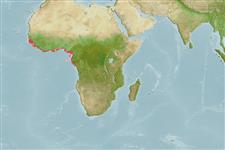Actinopterigi (pesci con pinne raggiate) >
Perciformes (Perch-likes) >
Sciaenidae (Drums or croakers)
Etymology: Pseudotolithus: Greek, pseudes = false + greek, otos = ear + Greek, lithos = stone (Ref. 45335).
Ambiente / Clima / Range
Ecologia
; marino; salmastro demersale; distribuzione batimetrica 0 - 100 m (Ref. 3593), usually 50 - 100 m (Ref. 26999). Tropical, preferred 26°C (Ref. 107945); 17°N - 6°S, 17°W - 14°E (Ref. 54743)
Eastern Atlantic: west coast of Africa, from Senegal to southern Angola (Ref. 3593, 57396).
Length at first maturity / Size / Peso / Age
Maturity: Lm 19.1 range ? - ? cm
Max length : 47.0 cm TL maschio/sesso non determinato; (Ref. 5752); common length : 30.0 cm TL maschio/sesso non determinato; (Ref. 3593)
Short description
Morfologia | Morfometria
Spine dorsali (totale): 11; Raggi dorsali molli (totale): 29-34; Spine anali 2; Raggi anali molli: 6. Diagnosis: medium-sized fish, fusiform and compressed; head short; eyes rather large; snout short; mouth large and oblique, subterminal; teeth villiform, set in narrow bands in both jaws; 5 marginal pores on snout and 6 mental pores; gill rakers long and slender, longer than gill filaments at angle of first gill arch; dorsal fin long, deeply notched; 2nd anal fin spine very strong, about as long as 1st soft ray and comprised less than twice in head length; caudal fin more or less pointed; scales ctenoid on body, cycloid on breast and head; lateral line extending to hind margin of caudal fin; swim bladder carrot-shaped, its front end with a pair of appendages subdividing into a group of short anterior branches and a bundle of 5-6 slender tubes extending backwards over half the length of swim bladder (Ref. 57396).
Coloration: back olivaceous brown, sides silvery with series of dark dots, belly light, yellowish during reproduction period; spinous part of dorsal fin dark, soft part lighter, with 2-3 longitudinal series of dark dots; pelvics and anal fin yellowish (Ref. 57396).
Found in coastal waters over mud bottom (Ref. 3593, 57396), very close to the shore (Ref. 57396). Also enters estuaries and coastal lagoons (Ref. 3593), where reproduction takes place (Ref. 57396). Moves farther offshore to about 100 m for spawning during rainy season from December to February; Feeds on fish and shrimps (Ref. 28587).
Life cycle and mating behavior
Maturità | Riproduzione | Deposizione | Uova | Fecundity | Larve
Chao, L.N. and E. Trewavas, 1990. Sciaenidae. p. 813-826. In J.C. Quero, J.C. Hureau, C. Karrer, A. Post and L. Saldanha (eds.) Check-list of the fishes the eastern tropical Atlantic (CLOFETA). JNICT, Lisbon; SEI, Paris; and UNESCO, Paris. Vol. 2. (Ref. 3593)
IUCN Red List Status (Ref. 115185)
CITES (Ref. 94142)
Not Evaluated
Threat to humans
Harmless
Human uses
Pesca: commerciale; Pesce da pesca sportiva: si
Informazioni ulteriori
BibliografiaAcquacolturaProfilo di acquacolturaVarietàGeneticaFrequenze allelicheEreditarietàMalattieElaborazioneMass conversion
CollaboratoriImmaginiStamps, CoinsSuoniCiguateraVelocitàModalità di nuotoArea branchialeOtolithsCervelliVista
Strumenti
Special reports
Download XML
Fonti Internet
